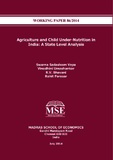| dc.contributor.author | Vepa, Swarna Sadasivam | |
| dc.contributor.author | Umashankar, Vinodhini | |
| dc.contributor.author | Bhavani, R.V. | |
| dc.contributor.author | Parasar, Rohit | |
| dc.coverage.spatial | India | en |
| dc.date.accessioned | 2016-08-15T11:01:54Z | |
| dc.date.available | 2016-08-15T11:01:54Z | |
| dc.date.issued | 2014-07 | |
| dc.identifier.citation | Vepa, S.S. et al., (2014) Agriculture and Child Under-Nutrition in India: A State Level Analysis, MSE Working Paper 86/2014. Chennai: Madras School of Economics. | en |
| dc.identifier.uri | https://opendocs.ids.ac.uk/opendocs/handle/20.500.12413/12150 | |
| dc.description.abstract | The literature review on agriculture-child nutrition linkage indicates that the evidence base is weak and inconclusive (Kadiyala et al., 2013). This paper explores the possible linkages between agricultural prosperity with rural child nutrition at the macro level, controlling for sanitation and safe drinking water, using panel data fixed effects and random effects models. The four alternate indicators of agricultural prosperity viz., agricultural growth, worker productivity, land productivity and food grain productionper capita used alternatively enable us to conclude that negative influence of agricultural prosperity on child undernutrition exists, though the influence of various aspects of prosperity on underweight and stunting differ. Other aspects of agriculture considered, such as female agricultural wages help to reinforce the negative influence of agricultural prosperity on underweight in children and the land operational inequality dampens the impact of agricultural prosperity as it increases the incidence of stunting. Water and sanitation help reduce child undernutrition albeit differently on stunting and underweight. The same set of variables seems to influence stunting and underweight differently. Their trajectories seem to differ. The present study enables us to conclude that Indian agricultural growth through higher food grain production and through higher land productivity, when percolates through, labour productivity and higher wages, can reduce child undernutrition in rural India. However, public policy has to promote social provisioning of sanitation and health and make sure that agricultural growth is consistent. Public policy should ensure that growth translates into higher labour productivity and higher wages. | en |
| dc.description.sponsorship | UK Aid | en |
| dc.description.sponsorship | Department for International Development (DFID) | en |
| dc.language.iso | en | en |
| dc.publisher | Madras School of Economics | en |
| dc.relation.ispartofseries | Working Paper;86/2014 | |
| dc.rights.uri | http://creativecommons.org/licenses/by-nc-nd/4.0/ | en |
| dc.subject | Agriculture | en |
| dc.subject | Nutrition | en |
| dc.subject | Rural Development | en |
| dc.title | Agriculture and Child Under-Nutrition in India: A State Level Analysis | en |
| dc.type | Series paper (non-IDS) | en |
| dc.rights.holder | Madras School of Economics | en |
| dcterms.dateAccepted | 2014-07 | |
| rioxxterms.funder | Department for International Development, UK Government | |
| rioxxterms.identifier.project | LANSA | |
| rioxxterms.version | NA | en |
| rioxxterms.funder.project | 752f8189-3789-4438-be29-585edbe66660 | |


